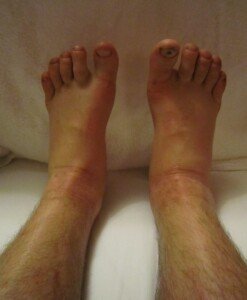
You can’t always tell by simply looking at your swollen puffy ankles if the cause is serious or benign.
If you’re worried about the bilateral swelling in your ankles, especially if it seems to be getting worse (do you use a tape measure?), then a visit to the doctor is in order.
If you’ve ever made a point to look at people’s ankles in public, it won’t be long before you come upon bilateral swelling or puffiness that appears to be out of proportion with the size of that person’s body, or in some way out of place – not a normal anatomical feature of that person.
You will eventually see swollen puffy ankles even in younger adults, not just the elderly or obese.
You’ll wonder how many have heart, liver or kidney problems, which are the serious causes of both ankles becoming swollen with excess fluid (edema).
Benign, Harmless Causes of Both Ankles Swelling Up
There are multiple benign causes of bilateral swelling of the ankles due to edema, says Susan L. Besser, MD, with Mercy Medical Center, Baltimore, and Diplomate American Board of Obesity Medicine and board certified by the American Board of Family Medicine.
Dr. Besser explains, “The most common benign causes for swelling are: leaving your legs hanging down for prolonged periods; too much salt in your diet (if you are salt sensitive); obesity; and certain medications (such as some blood pressure medications and NSAIDS like Ibuprofen) that cause swelling.
“So, the solutions are to get up and move around, lay off the salt, lose weight and talk with your PCP about medications that might be contributing to the problem.”

Swelling from prolonged air travel. James Heilman, MD, CreativeCommons
Something to Keep in Mind
Just because you might be eating too much salt, letting your legs hang down for long periods and using Ibuprofen doesn’t mean you don’t have a heart or liver issue that’s causing bilateral ankle edema!
Your doctor will get your medical history, ask you questions and get a feel for how likely the swelling in both of your ankles is possibly from an issue involving your organs vs. a benign origin.
The younger and fitter you are, the less likely that a serious cause will be behind the edema.
But younger people can, indeed, have problems with their heart, liver or kidneys.
While you’re waiting for your doctor’s appointment, make the aforementioned changes and see if they don’t make the swelling go away.
Though safe weight loss will take some time to make a difference in the appearance of your ankles, the other changes (if they’re related to the edema) will be very quick to show an improvement.
Tips on Salt Consumption

• In general, canned foods are high in salt unless specified as “low sodium.”
• Check the “serving size” for sodium content. The “serving size” is often designated as some fraction of the can or container which is much less than what you’d normally eat.
• Condiments are often relatively high in sodium.
• Soup at restaurants (and canned), the alleged health food, is notoriously high in sodium unless specified as low sodium.
 Dr. Besser provides comprehensive family care, treating common and acute primary conditions like diabetes and hypertension. Her ongoing approach allows her the opportunity to provide accurate and critical diagnoses of more complex conditions and disorders.
Dr. Besser provides comprehensive family care, treating common and acute primary conditions like diabetes and hypertension. Her ongoing approach allows her the opportunity to provide accurate and critical diagnoses of more complex conditions and disorders.
 Lorra Garrick has been covering medical, fitness and cybersecurity topics for many years, having written thousands of articles for print magazines and websites, including as a ghostwriter. She’s also a former ACE-certified personal trainer.
Lorra Garrick has been covering medical, fitness and cybersecurity topics for many years, having written thousands of articles for print magazines and websites, including as a ghostwriter. She’s also a former ACE-certified personal trainer.
.








































